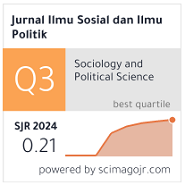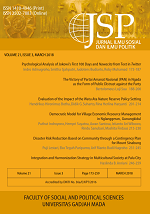Women and Hoax News Processing on WhatsApp
Hani Noor Ilahi(1*)
(1) University of Indonesia
(*) Corresponding Author
Abstract
The word hoax became popular with the development of technology that has potentially increased the circulation of hoax news. One of the ways hoax news circulates is through mobile instant messaging applications like WhatsApp, where users can interact directly, or between individuals who are members of a group. In Indonesia, by 2017, WhatsApp was the most used and the longestused mobile instant messaging application, having 35.87 million users. This study focuses on women using WhatsApp, as previous studies have shown that women dominate social media use in Indonesia. Using the elaboration likelihood model, this study aimed to investigate how women process hoax messages about child abduction on WhatsApp. The results of research through interviews and surveys indicate that women tend to process hoax messages about the abduction of children through peripheral lines. The lack of media literacy and the tendency to prioritize the emotional aspects of a story make some women vulnerable to spreading hoaxes through WhatsApp. In this study, the researchers recommend a digital empowerment movement to improve women’s media literacy through an online lecture model on WhatsApp. This program should be professionally managed by experts or academics from relevant fields of study.
Keywords
Full Text:
PDFReferences
Ananda, Marisa Rizky. (2013). Self-esteem Ibu Rumah Tangga yang Bekerja dengan yang Tidak Bekerja. Online Psychology Journal, UMM, Vol.1 No. 1. Malang: Universitas Muhamadiyah Malang
Anggraini, C. N. (2016). Literasi media baru dan penyebaran informasi hoaks. Yogyakarta: Universitas Gadjah Mada.
Batubara, H. (2016, October 27). Pesan berantai penculikan anak modus menyamar jadi ojek online. Retrieved November 7, 2017, from https://news.detik.com/berita/d-3330564/pesan-berantai-penculikan-anak-modus-menyamar-jadi-driver-ojek-online
Church, K. & de Oliveira. (2013, August 30). What’s up with whatsapp? comparing mobile instant messaging behaviors with traditional SMS. Retrieved from http://www.ic.unicamp.br/~oliveira/doc/MHCI2013_Whats-up-with-whatsapp.pdf
Dunn, Henry B. & Allen, Charlotte A. (2005). Rumors, Urban Legends, and Internet Hoaxes. In Johnston, T. C. (Eds.), Proceedings of The Annual Meetings of The Association of Collegiate Marketing Educators (pp. 85-91). Martin, TN, US: The University of Tennessee at Martin.
Fajriningtyas, C. (2016, May 6). Mengapa digital fluency Indonesia rendah?. Retrieved from https://www.accenture.com/t20160506T060137__w__/id-en/_acnmedia/Accenture/Conversion-Assets/DotCom/Documents/About-Accenture/PDF/3/Accenture-Femina-Vol-18-Indonesia-Digital-Fluency.pdf
Griffin, E. A. (2012). A first look at communication theory (8th Edition). New York: Mc Graw Hill.
Hennink, M., Hutter, I., Bailey, A. (2011). Qualitative Research Methods. Sage Publications
Littlejohn, S. (2002). Theories of human communication (Seventh Edition). USA: Thomson Learning.
Livingjohn, Sonia. (2003). The Changing Nature and Uses of Media Literacy. London: London School of Economics and Political Science
Milhorn, H. T. (2007). Cybercrime: how to avoid becoming a victim. Florida : Universal Publishers.
Nazmi, A. (2017, March 17). Beredar pesan penculikan anak di cimahi, kapores cimahi sebut berita hoax. Retrieved from http://jabar.tribunnews.com/2017/03/17/beredar-pesan-berantai-penculikan-anak-di-cimahi-kapolres-cimahi-sebut-berita-hoaks
Nugrahaedi, W. W. (2008). Faktor-faktor yang mempengaruhi sikap individu terhadap email hoax. Jakarta: University of Indonesia.
Nurdin, A. (2017, March 29). Hoax penculikan anak berujung korban. Retrieved from http://news.liputan6.com/read/2902507/hoax-penculikan-anak-berujung-korban on 7th November 2017
Petty R. E, & Cacioppo, J. T. (1986). The Elaboration Likelihood Model of Persuasion. USA: Academic Press Inc
Potter, W. J. (2012). Media literacy 6th Edition. London: Sage.
Prabowo, D. (2017, November 7). Kapolri: isu penculikan anak hoax. Kompas.com. Retrieved fromhttp://nasional.kompas.com/read/2017/03/23/11093071/kapolri.isu.penculikan.anak.hoax
Pratama, A. H. (2017). Laporan ComScore: Whatsapp adalah aplikasi terpopuler di Indonesia. Retrieved from https://id.techinasia.com/comscore-WhatsApp-adalah-aplikasi-terpopuler-di-indonesia
Salomon, D. (2006). Foundations of Computer Security. USA: Springer
Saner, E. (2016. July 3). From political coups to family feuds: how whatsapp became our favorite way to chat. Retrieved November 7, 2017, from https://www.theguardian.com/technology/2016/jul/03/from-political-coups-to-family-feuds-how-whatsapp-became-our-favourite-way-to-chat.
Triartanto. A. Y. (2015). Kredibilitas Teks Hoax di Media Siber. Jurnal Komunikasi, 6(2), 33-36. doi: 10.31294/jkom.v6i2.2464.g1700
Trisilowaty, D. (2012). Kebebasan informasi di era media online. Observasi Jurnal, 10(2), 127-134.
Wiratno, L. B., & Samudi. (2009). Perempuan dan literasi media. Jurnal Studi Gender dan Anak, 4(2), 181-197.
Article Metrics
Refbacks
- There are currently no refbacks.
Copyright (c) 2019 Jurnal Ilmu Sosial dan Ilmu Politik

This work is licensed under a Creative Commons Attribution-NonCommercial-NoDerivatives 4.0 International License.






















